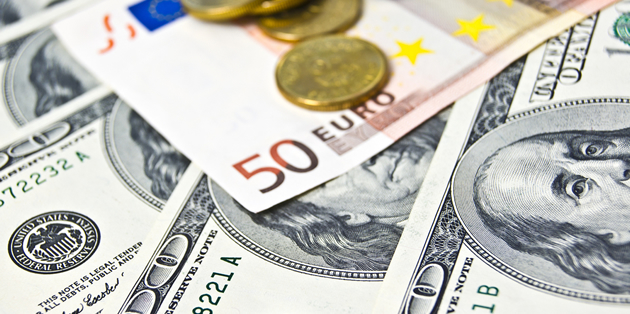- Opinion polls showed increasing ‘Leave’ camp support – Pound demand weakened by heightened odds of ‘Brexit’
- Euro softened by negative Eurozone inflation – Spanish and Italian CPI remained negative on the year
- Safe-haven demand bolstered US Dollar – Worries over China and ‘Brexit’ increased risk aversion
- GBP/USD exchange rate volatility forecast ahead of Fed rate decision – Market jitters likely despite low odds of imminent interest rate hike
GBP Exchange Rate Trends Higher ahead of UK Employment Data Today
Confidence in the Pound (GBP) picked up somewhat on Wednesday morning, even though expectations are not high for the latest raft of UK employment data. Growth in average weekly earnings is forecast to have slowed in the three months to April, a result which could see Sterling return to a general downtrend.
Nevertheless, the Pound Sterling to Euro (GBP/EUR) exchange rate was trending higher at 1.2633, while the Pound Sterling to US Dollar (GBP/USD) pairing was making gains around 14164.
(Previously updated at 17:01 on 14/06/2016)
Stronger US Retail Sales Weighed on GBP/USD Exchange Rate
US Advance Retail Sales bettered expectations to clock in at 0.5% rather than 0.3% in May, indicating stronger demand within the world’s largest economy. Although this is unlikely to impact the attitude of the Fed at tomorrow’s policy decision the Pound Sterling to US Dollar (GBP/USD) exchange rate nevertheless extended its slump to trend lower in the region of 1.4130.
(Previously updated at 11:03 on 14/06/2016)
Pound Sterling (GBP) Struggled to Make Gains Following Discouraging ‘Brexit’ Polls
Confidence in Pound Sterling (GBP) continued to weaken at the start of the week, thanks to a general intensification of ‘Brexit’ worries within markets. Investors were discouraged by the latest round of opinion polls, which seemed to indicate that the ‘Leave’ campaign was pulling ahead of its rival. As researchers at ANZ noted:
‘A new poll by ICM/The Guardian showed a 53% to leave and 47% to stay, excluding the ”don’t knows”. Including the ”don’t knows”, the phone poll was 50% leave, 45% stay, 5% don’t know. The online split was 49% leave, 44% remain, and 7% “don’t know”. The previous poll on 31 May showed 45% leave, 42% stay, and 13% undecided.’
This encouraged higher odds that the UK will vote to leave the EU next week, prompting the Pound to weaken substantially across the board.
Markets had anticipated that May’s UK Consumer Price Index would strengthen marginally from 0.3% to 0.4%, a result which would have affirmed that the impact of referendum uncertainty on the wider economy had been more limited than feared. However, as inflation remained steady at just 0.3% on the year the hopes of progress towards the Bank of England’s (BoE) 2% target were dashed. Even so, apparent relief from investors not to have seen a greater disappointment in light of recent volatility allowed the Pound Sterling to Euro (GBP/EUR) exchange rate to return to a narrow uptrend.
Negative Inflation Data Weighed on Euro (EUR) Exchange Rate
Comments from Bundesbank President Jens Weidmann helped to bolster the Euro (EUR) on Monday, as the policymaker took his typically hawkish tone on monetary policy. Although Weidmann is a notorious hawk, markets were nevertheless encouraged by his suggestion that the European Central Bank (ECB) will not loosen policy further in the near future. There have been doubts about the ECB’s apparent ‘wait and see’ mentality but the diminished prospect of additional easing measures prompted the single currency to rally strongly.
Demand for the Euro turned a little more muted on Tuesday morning, however, following the publication of the latest Spanish and Italian Consumer Price Index data. Although inflationary pressure was found to have edged higher in both countries this failed to offer particular encouragement to investors. Annual inflation remained negative at -0.3% in Italy and -1.0% in Spain, suggesting that the ECB’s recent easing measures are failing to have a significant impact. Exposure to ‘Brexit’ risk has also been adding downside pressure to the single currency.
US Dollar (USD) Volatility Forecast on Retail Sales and Fed Meeting
A general decline in risk appetite shored up the appeal of the US Dollar (USD) at the start of the week, with concerns over ‘Brexit’ and China prompting a general move towards safe-haven assets. Weaker-than-expected Chinese Retail Sales and Foreign Direct Investment figures resurrected worries that the country could be heading for a hard landing, helping to push the Pound Sterling to US Dollar (GBP/USD) exchange rate to a three-month low of 1.4123.
The appeal of the ‘Greenback’ could weaken this afternoon in response to the latest Advance Retail Sales report. Forecasts point towards a substantial dip in consumer demand from 1.3% to 0.3% in May, which would seem to indicate that confidence within the world’s largest economy is weakening. The US Dollar is also likely to see volatility ahead of the Federal Open Market Committee’s (FOMC) policy meeting on Wednesday, even though there is no expectation of a change in interest rates.
Current GBP, EUR, USD Exchange Rates
At the time of writing, the Pound Sterling to Euro (GBP/EUR) exchange rate was trending higher at 1.2593, while the Pound Sterling to US Dollar (GBP/USD) pairing was slumped around 1.4150. Meanwhile, the Euro to US Dollar (EUR/USD) exchange rate was ceding ground in the region of 1.1236.



